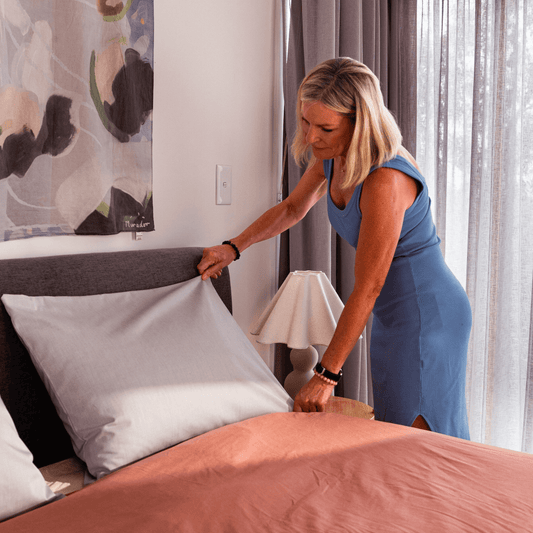
Grounding and Jet Lag: How Earthing Can Help Reset Your Body Clock
Earthing (grounding) can be a powerful jet lag remedy. By making direct contact with the Earth’s surface – or using grounding tools like mats and sheets – travelers absorb the Earth’s natural electric charge, which helps rebalance the body’s internal clock.
This simple practice reduces inflammation, lowers stress hormones, and promotes better sleep, all of which are disrupted during long flights. In effect, grounding after travel helps you adjust to a new time zone faster and feel more refreshed.
Key Benefits of Earthing for Jet Lag:
- Resets circadian rhythm: Reinforces your body’s natural sleep-wake cycle after crossing time zones.
- Reduces inflammation: Eases the inflammation and stress response often triggered by flying.
- Improves sleep quality: Promotes deeper, more restorative sleep to speed recovery from jet lag.
- Balances cortisol levels: Helps normalize cortisol (the stress hormone) for an easier time zone adaptation.
In summary, grounding is a science-backed method for travelers to combat jet lag and restore their internal clock. Below, we explore why jet lag upsets your body, how earthing counteracts those effects, and practical grounding tips for your next journey.
Why Does Jet Lag Disrupt the Body Clock?
Jet lag is a temporary sleep disorder caused by rapid travel across multiple time zones. It throws off your circadian rhythm, the 24-hour internal clock that regulates your sleep-wake cycle, hormone release, digestion, and other bodily functions. Suddenly, your body thinks it’s one time while the local environment is on a different schedule. Common symptoms of jet lag include fatigue, insomnia (or restless sleep), poor concentration, mood changes, and even digestive issues.
The primary reason is that your circadian cues, especially light exposure, are out of sync with the new local time. Until your internal clock adjusts (which can take days), you may feel “off” and sluggish. Long flights also tend to cause dehydration and elevated stress hormones, compounding the fatigue. Essentially, jet lag is your body’s way of saying its natural rhythms are out of balance.
How Grounding Helps Reset Your Body Clock
Grounding directly addresses several factors of jet lag. When you land and connect with the earth – by walking barefoot on grass, soil, sand, or even using a grounding mat – you help recalibrate your circadian rhythm and reduce the stress of travel. Here’s how it works:
- Syncs your circadian rhythm: Exposure to the Earth’s electrons may help signal your body that it’s “in contact” with the new environment. Grounding outdoors during daylight hours can reinforce natural light cues, helping your internal clock synchronize to the local day-night cycle. In essence, earthing gives your body a nudge toward the new schedule.
- Lowers stress and inflammation: Long flights elevate cortisol (a stress hormone) and can trigger inflammation from prolonged sitting and radiation exposure at high altitude. Earthing has been shown to reduce markers of inflammation and bring down cortisol levels, creating a calmer physiological state. By lowering stress hormones, grounding makes it easier for your body to unwind and transition to sleep at the appropriate local time.
- Improves sleep quality: One of the most significant benefits of earthing is deeper, more restorative sleep. Travelers who ground themselves often report falling asleep faster and sleeping more soundly after a flight. This is partly because grounding before bedtime can normalize your cortisol cycle (high in the morning, low at night) to align with the new time zone. In a pilot study, people who slept grounded during travel had resynchronized cortisol secretion aligned to the 24-hour day, with fewer sleep disturbances. Better sleep means quicker recovery from jet lag.
Simply put, earthing helps your body clock reset more rapidly. It acts as a natural antidote to jet lag’s disorienting effects, helping you feel balanced again.
Scientific Evidence Supporting Earthing for Jet Lag
Grounding might sound simple, but it’s backed by emerging research. Several studies over the past two decades have documented how connecting to Earth affects physiology:
- Cortisol normalization: A landmark 2004 study in the Journal of Alternative and Complementary Medicine found that subjects who slept grounded had significantly improved sleep and normalized cortisol rhythms compared to before. Their cortisol hormone cycle aligned more closely with a healthy circadian pattern, indicating reduced jet lag–like stress on the body.
- Reduced stress and pain: Follow-up studies noted that grounding can lower stress, pain, and even blood viscosity. For example, research published in 2006 observed reduced pain and improved sleep in chronic pain patients using grounding techniques. Lower stress and pain levels mean your body can adjust to a new time zone without the added burden of physical discomfort.
- General health improvements: A 2012 review in the Journal of Environmental and Public Health concluded that earthing has broad benefits – from reduced inflammation and better sleep to improved blood flow. All these effects contribute to faster recovery after travel. When you’re grounded, your body is simply in a better state to heal and realign its rhythms.
While specific “jet lag and grounding” studies are still limited, these findings collectively explain why travelers often swear by earthing. By normalizing stress hormones and promoting homeostasis, grounding helps mitigate the biological upheaval caused by rapid time zone changes.
Practical Grounding Tips for Travelers
If you’re flying across time zones, incorporating a few grounding practices during and after your journey can make a noticeable difference in how you feel. Here are some practical tips to help reset your body clock naturally:
- Get barefoot on arrival: As soon as feasible after you land, find a patch of grass, bare earth, or even unsealed concrete outside your hotel or airport. Remove your shoes and socks and stand or walk barefoot for at least 20–30 minutes. This direct earth contact floods your body with balancing electrons. Many travelers report that a barefoot walk in a park or on damp grass greatly reduces their jet lag fatigue.
- Absorb natural sunlight: Combine grounding with sunlight exposure if possible. Daylight is a powerful cue for your circadian rhythm. Ground yourself outdoors in the morning or early afternoon of your new location – for example, sit or picnic on the grass at a park. The combination of earthing and natural light sends a strong “daytime” signal to your internal clock, helping suppress melatonin during the day and boost it at night.
- Use grounding tools in-flight and indoors: When natural ground isn’t accessible (such as during your flight or in a high-rise hotel), you can use portable grounding products. For instance, a travel-size grounding mat or grounding bedsheet can plug into the airplane seat outlet or a grounded wall outlet in your hotel room. Lying or placing your feet on a grounded mat during a long flight can help neutralize some of the excess static and inflammation from flying. Using a grounding bed sheet at your destination overnight will continue the earthing process as you sleep, assisting your body clock to adjust.
- Ground during layovers: If you have a layover between flights, use it wisely. Step outside the airport if you can, and do some quick earthing – even 10 minutes of standing on a patch of soil or touching a live tree can help. Many airports now have courtyards or outdoor areas; find one and kick off your shoes. It’s a great way to recharge your body before the next flight leg.
- Stay hydrated and eat grounding foods: This isn’t earthing in the literal sense, but it complements it. Drink plenty of water to counteract the dry airplane air, and consider eating a meal rich in fresh vegetables or fruit after flying. Some travelers also swear by “grounding foods” like root vegetables (think carrots, sweet potatoes), which symbolically and nutritionally support reconnection to Earth. While diet isn’t a substitute for physical grounding, every bit helps in recovering your equilibrium.
- Grounding upon waking and before sleep: At your destination, try a brief grounding session in the morning and evening. In the morning, it can signal your body to be alert; in the evening, it can signal it to wind down. For example, do a barefoot walk at dawn if you wake up too early, or do some gentle stretches with your palms on the ground in the afternoon. At night, if you’re struggling with insomnia, stepping outside and placing your bare feet on cool ground for a few minutes might help calm your overactive nerves and prepare you for sleep.
Even simple habits like touching a tree or walking on a beach can make a difference. Remember, surfaces like grass, soil, sand, and unsealed concrete are conductive and will ground you, whereas asphalt or wooden decks will not ground you. So seek out natural terrain when possible.
Conclusion
Jet lag doesn’t have to derail your trip. Grounding is a natural, accessible tool to help your body adapt when you travel across time zones. By reconnecting with the Earth’s energy, you can steady your circadian rhythm, reduce the inflammation and stress of flying, and enjoy deeper sleep in a new locale. Many travelers describe earthing as a “reset button” for the body clock – a way to feel centered and energized rather than foggy and fatigued.
The next time you embark on a long flight, plan some grounding moments into your itinerary. Kick off your shoes upon arrival and let your feet touch the earth. Use a grounding mat or bedsheet on the plane or in your hotel room to continue the effect. These small actions can pay off with big benefits: you’ll likely find you adjust to the new time zone faster and with less discomfort. Instead of enduring days of jet lag, you’ll be more present and ready to enjoy your destination.
References
Ghaly, M., & Teplitz, D. (2004). The biologic effects of grounding the human body during sleep as measured by cortisol levels and subjective reporting of sleep, pain, and stress. Journal of Alternative & Complementary Medicine, 10(5), 767-776. https://doi.org/10.1089/acm.2004.10.767
Lin, C. H., Tseng, S. T., Chuang, Y. C., Kuo, C. E., & Chen, N. C. (2022). Grounding the body improves sleep quality in patients with mild Alzheimer’s disease: A pilot study. Healthcare (Basel), 10(3), Article 581. https://doi.org/10.3390/healthcare10030581
Park, H.-J., Jeong, W., Yu, H. J., Ye, M., Hong, Y., Kim, M., Kim, J. Y., & Shim, I. (2023). The effect of earthing mat on stress-induced anxiety-like behavior and neuroendocrine changes in the rat. Biomedicines, 11(1), 57. https://doi.org/10.3390/biomedicines11010057







